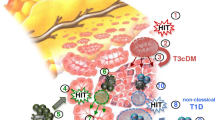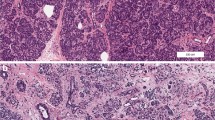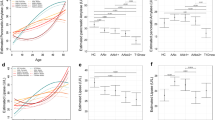Abstract
Type 2 diabetes mellitus (T2DM) has insulin resistance (IR) or reduced β-cell mass, partially due to an increased β-cell apoptosis rate. Pancreatic stone protein/regenerating protein (PSP/reg) is a secretory protein produced in the pancreas and up-regulated dramatically during pancreatic disease. Recent studies revealed that β-cells undergoing apoptosis induce PSP/reg expression in surviving neighboring cells. Further experiments demonstrated that PSP/reg was elevated during disease progression in type 1 diabetes mellitus (T1DM). However, the association between PSP/reg and T2DM patients is unknown. The aim of this pilot study was to investigate PSP/reg in different clinical stages of T2DM and evaluate its correlation with chronic complications of diabetes. A total of 1,121 participants (479 males, 642 females; age range 23–80 years) were enrolled in this study. PSP/reg serum values were measured by a newly developed enzyme-linked immunosorbent assay (ELISA). We analyzed its correlation with clinical and biochemical parameters in subjects with T2DM at different clinical phases. Statistical analyses were conducted using SPSS 17.0 software. Correlations of PSP/reg and clinical parameters were performed using Spearman’s rank correlation coefficient. Differences between groups were determined by Nemenyi test. PSP/reg was elevated in high-risk and impaired glucose regulation (IGR) patients (p < 0.05). PSP/reg was significantly up-regulated in newly diagnosed T2DM patients and long-term diabetes patients with complications (p < 0.001). PSP/reg levels correlated with the duration of diabetes (p < 0.001). The area under the curve (AUC) for presence of diabetes-onset and its chronic complications was 0.640 and 0.754, respectively. PSP/reg is significantly up-regulated in T2DM patients, and PSP/reg levels are related to the duration of diabetes. Therefore, PSP/reg might be useful as a predictor of T2DM and disease progression.



Similar content being viewed by others
References
G. Danaei, M.M. Finucane, Y. Lu, G.M. Singh, M.J. Cowan, C.J. Paciorek, J.K. Lin, F. Farzadfar, Y.H. Khang, G.A. Stevens, M. Rao, M.K. Ali, L.M. Riley, C.A. Robinson, M. Ezzati, National, regional, and global trends in fasting plasma glucose and diabetes prevalence since 1980: systematic analysis of health examination surveys and epidemiological studies with 370 country-years and 2.7 million participants. Lancet 378(9785), 31–40 (2011). doi:10.1016/S0140-6736(11)60679-X
Y. Xu, L. Wang, J. He, Y. Bi, M. Li, T. Wang, Y. Jiang, M. Dai, J. Lu, M. Xu, Y. Li, N. Hu, J. Li, S. Mi, C.S. Chen, G. Li, Y. Mu, J. Zhao, L. Kong, J. Chen, S. Lai, W. Wang, W. Zhao, G. Ning, Prevalence and control of diabetes in Chinese adults. JAMA 310(9), 948–959 (2013). doi:10.1001/jama.2013.168118
Standards of medical care in diabetes–2012. Diabetes Care 35 Suppl 1, S11–S63 (2012). doi:10.2337/dc12-s011
A. Qaseem, L.L. Humphrey, D.E. Sweet, M. Starkey, P. Shekelle, Oral pharmacologic treatment of type 2 diabetes mellitus: a clinical practice guideline from the American College of Physicians. Ann. Intern. Med. 156(3), 218–231 (2012). doi:10.7326/0003-4819-156-3-201202070-00011
A.E. Butler, J. Janson, S. Bonner-Weir, R. Ritzel, R.A. Rizza, P.C. Butler, Beta-cell deficit and increased beta-cell apoptosis in humans with type 2 diabetes. Diabetes 52(1), 102–110 (2003)
L.C. Jones, A. Clark, Beta-cell neogenesis in type 2 diabetes. Diabetes 50(Suppl 1), S186–S187 (2001)
T. Watanabe, H. Yonekura, K. Terazono, H. Yamamoto, H. Okamoto, Complete nucleotide sequence of human reg gene and its expression in normal and tumoral tissues. The reg protein, pancreatic stone protein, and pancreatic thread protein are one and the same product of the gene. J. Biol. Chem. 265(13), 7432–7439 (1990)
R. Graf, M. Schiesser, G.A. Scheele, K. Marquardt, T.W. Frick, R.W. Ammann, D. Bimmler, A family of 16-kDa pancreatic secretory stress proteins form highly organized fibrillar structures upon tryptic activation. J. Biol. Chem. 276(24), 21028–21038 (2001). doi:10.1074/jbc.M010717200
W. Schmiegel, M. Burchert, H. Kalthoff, C. Roeder, G. Butzow, H. Grimm, B. Kremer, N. Soehendra, H.W. Schreiber, H.G. Thiele et al., Immunochemical characterization and quantitative distribution of pancreatic stone protein in sera and pancreatic secretions in pancreatic disorders. Gastroenterology 99(5), 1421–1430 (1990)
L. Multigner, A. De Caro, D. Lombardo, D. Campese, H. Sarles, Pancreatic stone protein, a phosphoprotein which inhibits calcium carbonate precipitation from human pancreatic juice. Biochem Biophys Res Commun 110(1), 69–74 (1983)
M.J. Llewelyn, M. Berger, M. Gregory, R. Ramaiah, A.L. Taylor, I. Curdt, F. Lajaunias, R. Graf, S.J. Blincko, S. Drage, J. Cohen, Sepsis biomarkers in unselected patients on admission to intensive or high-dependency care. Crit. Care 17(2), R60 (2013). doi:10.1186/cc12588
L. Boeck, R. Graf, P. Eggimann, H. Pargger, D.A. Raptis, N. Smyrnios, N. Thakkar, M. Siegemund, J. Rakic, M. Tamm, D. Stolz, Pancreatic stone protein: a marker of organ failure and outcome in ventilator-associated pneumonia. Chest 140(4), 925–932 (2011). doi:10.1378/chest.11-0018
A. Scherr, R. Graf, M. Bain, M. Christ-Crain, B. Muller, M. Tamm, D. Stolz, Pancreatic stone protein predicts positive sputum bacteriology in exacerbations of COPD. Chest 143(2), 379–387 (2013). doi:10.1378/chest.12-0730
M. Keel, L. Harter, T. Reding, L.K. Sun, M. Hersberger, B. Seifert, D. Bimmler, R. Graf, Pancreatic stone protein is highly increased during posttraumatic sepsis and activates neutrophil granulocytes. Crit. Care Med. 37(5), 1642–1648 (2009). doi:10.1097/CCM.0b013e31819da7d6
C. Bonner, S. Bacon, C.G. Concannon, S.R. Rizvi, M. Baquie, A.M. Farrelly, S.M. Kilbride, H. Dussmann, M.W. Ward, C.M. Boulanger, C.B. Wollheim, R. Graf, M.M. Byrne, J.H. Prehn, INS-1 cells undergoing caspase-dependent apoptosis enhance the regenerative capacity of neighboring cells. Diabetes 59(11), 2799–2808 (2010). doi:10.2337/db09-1478
S. Bacon, M.P. Kyithar, J. Schmid, S.R. Rizvi, C. Bonner, R. Graf, J.H. Prehn, M.M. Byrne, Serum levels of pancreatic stone protein (PSP)/reg1A as an indicator of beta-cell apoptosis suggest an increased apoptosis rate in hepatocyte nuclear factor 1 alpha (HNF1A-MODY) carriers from the third decade of life onward. BMC endocrine disorders 12, 13 (2012). doi:10.1186/1472-6823-12-13
Executive summary: standards of medical care in diabetes–2014. Diabetes Care 37 Suppl 1, S5–S3 (2014). doi:10.2337/dc14-S005
D.A. de Luis, N. Fernandez, M.L. Arranz, R. Aller, O. Izaola, E. Romero, Total homocysteine levels relation with chronic complications of diabetes, body composition, and other cardiovascular risk factors in a population of patients with diabetes mellitus type 2. J. Diabetes Complications 19(1), 42–46 (2005). doi:10.1016/j.jdiacomp.2003.12.003
M. Schiesser, D. Bimmler, T.W. Frick, R. Graf, Conformational changes of pancreatitis-associated protein (PAP) activated by trypsin lead to insoluble protein aggregates. Pancreas 22(2), 186–192 (2001)
L. Li, D. Bimmler, R. Graf, S. Zhou, Z. Sun, J. Chen, M. Siech, M.G. Bachem, PSP/reg inhibits cultured pancreatic stellate cell and regulates MMP/TIMP ratio. Eur. J. Clin. Invest. 41(2), 151–158 (2011). doi:10.1111/j.1365-2362.2010.02390.x
R. Gukasjan, D.A. Raptis, H.U. Schulz, W. Halangk, R. Graf, Pancreatic stone protein predicts outcome in patients with peritonitis in the ICU. Crit. Care Med. 41(4), 1027–1036 (2013). doi:10.1097/CCM.0b013e3182771193
D. Bimmler, E. Angst, F. Valeri, M. Bain, G.A. Scheele, T.W. Frick, R. Graf, Regulation of PSP/reg in rat pancreas: immediate and steady-state adaptation to different diets. Pancreas 19(3), 255–267 (1999)
R. Graf, M. Schiesser, T. Reding, P. Appenzeller, L.K. Sun, F. Fortunato, A. Perren, D. Bimmler, Exocrine meets endocrine: pancreatic stone protein and regenerating protein–two sides of the same coin. J. Surg. Res. 133(2), 113–120 (2006). doi:10.1016/j.jss.2005.09.030
J.L. Iovanna, V. Keim, A. Bosshard, B. Orelle, J.M. Frigerio, N. Dusetti, J.C. Dagorn, PAP, a pancreatic secretory protein induced during acute pancreatitis, is expressed in rat intestine. Am. J. Physiol. 265(4 Pt 1), G611–G618 (1993)
P.L. de la Porte, A. de Caro, H. Lafont, H. Sarles, Immunocytochemical localization of pancreatic stone protein in the human digestive tract. Pancreas 1(4), 301–308 (1986)
M. Asahara, S. Mushiake, S. Shimada, H. Fukui, Y. Kinoshita, C. Kawanami, T. Watanabe, S. Tanaka, A. Ichikawa, Y. Uchiyama, Y. Narushima, S. Takasawa, H. Okamoto, M. Tohyama, T. Chiba, Reg gene expression is increased in rat gastric enterochromaffin-like cells following water immersion stress. Gastroenterology 111(1), 45–55 (1996)
F.J. Livesey, J.A. O’Brien, M. Li, A.G. Smith, L.J. Murphy, S.P. Hunt, A Schwann cell mitogen accompanying regeneration of motor neurons. Nature 390(6660), 614–618 (1997). doi:10.1038/37615
H. Okamoto, The Reg gene family and Reg proteins: with special attention to the regeneration of pancreatic beta-cells. J Hepatobiliary Pancreat Surg 6(3), 254–262 (1999)
M.Y. Donath, Targeting inflammation in the treatment of type 2 diabetes: time to start. Nat Rev Drug Discov 13(6), 465–476 (2014)
M. Fraig, U. Shreesha, D. Savici, A.L. Katzenstein, Respiratory bronchiolitis: a clinicopathologic study in current smokers, ex-smokers, and never-smokers. Am J Surg Pathol 26(5), 647–653 (2002)
G. Engström, N. Segelstorm, M. Ekberg-Aronsson, P.M. Nilsson, F. Lindgärde, C.G. Löfdahl, Plasma markers of inflammation and incidence of hospitalisations for COPD: results from a population-based cohort study. Thorax 64(3), 211–215 (2009)
V. Vaccarino, T.R. Holford, H.M. Krumholz, Pulse pressure and risk for myocardial infarction and heart failure in the elderly. J. Am. Coll. Cardiol. 36(1), 130–138 (2000)
R. Ross, Atherosclerosis—an inflammatory disease. N Engl J Med 340(2), 115–126 (1999)
Acknowledgments
We would like to thank Martha Bain for excellent technical support. The project was supported in part by the Chinese Natural Science Foundation No.81270010, 30900696, 81170716 and the Gebert Rüf Foundation, GRS014/12 (Switzerland).
Conflict of interest
Rolf Graf is inventor of PSP in sepsis (Method for assaying sepsis in humans) for which the University of Zurich holds a patent.
Author information
Authors and Affiliations
Corresponding authors
Additional information
Jiayue Yang and Ling Li have contributed equally to this article. Zilin Sun and Rolf Graf contributed equally and are co-corresponding authors.
Rights and permissions
About this article
Cite this article
Yang, J., Li, L., Raptis, D. et al. Pancreatic stone protein/regenerating protein (PSP/reg): a novel secreted protein up-regulated in type 2 diabetes mellitus. Endocrine 48, 856–862 (2015). https://doi.org/10.1007/s12020-014-0427-3
Received:
Accepted:
Published:
Issue Date:
DOI: https://doi.org/10.1007/s12020-014-0427-3




